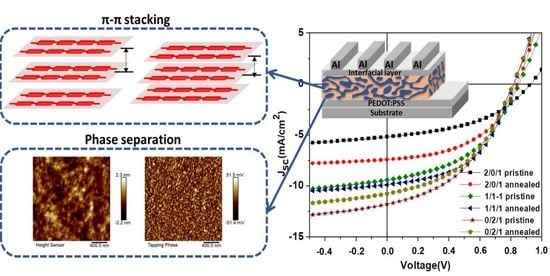π–π Stacking Distance and Phase Separation Controlled Efficiency in Stable All-Polymer Solar Cells
Abstract
1. Introduction
2. Experimental Section
2.1. Device Preparation and Characterization
2.2. Electroluminescence Measurement
2.3. GIWAXS
2.4. Contact Angle Measurement
2.5. AFM
3. Results and Discussions
3.1. Device Performance and Thermal Stability
3.2. Morphology and Molecular Packing Structure
3.3. Hole Conductivity in Different Binary Blends
4. Conclusions
Supplementary Materials
Author Contributions
Funding
Acknowledgments
Conflicts of Interest
References
- Lee, C.; Lee, S.; Kim, G.U.; Lee, W.; Kim, B.J. Recent advances, design guidelines, and prospects of all-polymer solar cells. Chem. Rev. 2019, 119, 8028–8086. [Google Scholar] [CrossRef] [PubMed]
- Traverse, C.J.; Pandey, R.; Barr, M.C.; Lunt, R.R. Emergence of highly transparent photovoltaics for distributed applications. Nat. Energy 2017, 2, 849–860. [Google Scholar] [CrossRef]
- Jinno, H.; Fukuda, K.; Xu, X.M.; Park, S.; Suzuki, Y.; Koizumi, M.; Yokota, T.; Osaka, I.; Takimiya, K.; Someya, T. Stretchable and waterproof elastomer-coated organic photovoltaics for washable electronic textile applications. Nat. Energy 2017, 2, 780–785. [Google Scholar] [CrossRef]
- Meng, L.; Zhang, Y.; Wan, X.; Li, C.; Zhang, X.; Wang, Y.; Ke, X.; Xiao, Z.; Ding, L.; Xia, R.; et al. Organic and solution-processed tandem solar cells with 17.3% efficiency. Science 2018, 361, 1094–1098. [Google Scholar] [CrossRef] [PubMed]
- Lee, W.; Kim, J.H.; Kim, T.; Kim, S.; Lee, C.; Kim, J.S.; Ahn, H.; Kim, T.S.; Kim, B.J. Mechanically robust and high-performance ternary solar cells combining the merits of all-polymer and fullerene blends. J. Mater. Chem. A 2018, 6, 4494–4503. [Google Scholar] [CrossRef]
- Yuan, J.; Zhang, Y.Q.; Zhou, L.Y.; Zhang, G.C.; Yip, H.L.; Lau, T.K.; Lu, X.H.; Zhu, C.; Peng, H.J.; Johnson, P.A.; et al. Single-junction organic solar cell with over 15% efficiency using fused-ring acceptor with electron-deficient core. Joule 2019, 3, 1140–1151. [Google Scholar] [CrossRef]
- Zhang, S.Q.; Qin, Y.P.; Zhu, J.; Hou, J.H. Over 14% efficiency in polymer solar cells enabled by a chlorinated polymer donor. Adv. Mater. 2018, 30, 1800868. [Google Scholar] [CrossRef]
- Yan, H.; Tang, Y.B.; Sui, X.Y.; Liu, Y.C.; Gao, B.W.; Liu, X.F.; Liu, S.F.; Hou, J.H.; Ma, W. Increasing quantum efficiency of polymer solar cells with efficient exciton splitting and long carrier lifetime by molecular doping at heterojunctions. ACS Energy Lett. 2019, 4, 1356–1363. [Google Scholar] [CrossRef]
- Yan, H.; Chen, J.Y.; Zhou, K.; Tang, Y.B.; Meng, X.Y.; Xu, X.B.; Ma, W. Lewis acid doping induced synergistic effects on electronic and morphological structure for donor and acceptor in polymer solar cells. Adv. Energy Mater. 2018, 8, 1703672. [Google Scholar] [CrossRef]
- McNeill, C.R. Morphology of all-polymer solar cells. Energ Environ. Sci. 2012, 5, 5653–5667. [Google Scholar] [CrossRef]
- Kang, H.; Lee, W.; Oh, J.; Kim, T.; Lee, C.; Kim, B.J. From fullerene-polymer to all-polymer solar cells: The importance of molecular packing, orientation, and morphology control. Acc. Chem. Res. 2016, 49, 2424–2434. [Google Scholar] [CrossRef] [PubMed]
- Benten, H.; Mori, D.; Ohkita, H.; Ito, S. Recent research progress of polymer donor/polymer acceptor blend solar cells. J. Mater. Chem. A 2016, 4, 5340–5365. [Google Scholar] [CrossRef]
- Kim, T.; Kim, J.H.; Kang, T.E.; Lee, C.; Kang, H.; Shin, M.; Wang, C.; Ma, B.W.; Jeong, U.; Kim, T.S.; et al. Flexible, highly efficient all-polymer solar cells. Nat. Commun. 2015, 6, 8547. [Google Scholar] [CrossRef] [PubMed]
- Zhou, N.J.; Facchetti, A. Naphthalenediimide (ndi) polymers for all-polymer photovoltaics. Mater. Today 2018, 21, 377–390. [Google Scholar] [CrossRef]
- Zhou, K.; Wu, Y.; Liu, Y.F.; Zhou, X.B.; Zhang, L.; Ma, W. Molecular orientation of polymer acceptor dominates open-circuit voltage losses in all-polymer solar cells. ACS Energy Lett. 2019, 4, 1057–1064. [Google Scholar] [CrossRef]
- Halls, J.J.M.; Walsh, C.A.; Greenham, N.C.; Marseglia, E.A.; Friend, R.H.; Moratti, S.C.; Holmes, A.B. Efficient photodiodes from interpenetrating polymer networks. Nature 1995, 376, 498–500. [Google Scholar] [CrossRef]
- Fan, B.B.; Ying, L.; Zhu, P.; Pan, F.L.; Liu, F.; Chen, J.W.; Huang, F.; Cao, Y. All-polymer solar cells based on a conjugated polymer containing siloxane-functionalized side chains with efficiency over 10%. Adv. Mater. 2017, 29, 1703906. [Google Scholar] [CrossRef]
- Fan, B.B.; Ying, L.; Wang, Z.F.; He, B.T.; Jiang, X.F.; Huang, F.; Cao, Y. Optimisation of processing solvent and molecular weight for the production of green-solvent-processed all-polymer solar cells with a power conversion efficiency over 9%. Energ Environ. Sci. 2017, 10, 1243–1251. [Google Scholar] [CrossRef]
- Kim, S.W.; Choi, J.; Bui, T.T.T.; Lee, C.; Cho, C.; Na, K.; Jung, J.; Song, C.E.; Ma, B.; Lee, J.Y.; et al. Rationally designed donor-acceptor random copolymers with optimized complementary light absorption for highly efficient all-polymer solar cells. Adv. Funct. Mater. 2017, 27, 1703070. [Google Scholar] [CrossRef]
- Zhou, K.; Zhang, R.; Liu, J.G.; Li, M.G.; Yu, X.H.; Xing, R.B.; Han, Y.C. Donor/acceptor molecular orientation-dependent photovoltaic performance in all-polymer solar cells. ACS Appl. Mater. Interfaces 2015, 7, 25352–25361. [Google Scholar] [CrossRef]
- Xu, X.F.; Li, Z.J.; Zhang, W.; Meng, X.Y.; Zou, X.S.; Rasi, D.D.; Ma, W.; Yartsev, A.; Andersson, M.R.; Janssen, R.A.J.; et al. 8.0% efficient all-polymer solar cells with high photovoltage of 1.1 v and internal quantum efficiency near unity. Adv. Energy Mater. 2018, 8, 1700908. [Google Scholar] [CrossRef]
- Feng, S.Z.; Liu, C.; Xu, X.F.; Liu, X.C.; Zhang, L.J.; Nian, Y.W.; Cao, Y.; Chen, J.W. Siloxane-terminated side chain engineering of acceptor polymers leading to over 7% power conversion efficiencies in all-polymer solar cells. ACS Macro Lett. 2017, 6, 1310–1314. [Google Scholar] [CrossRef]
- Zhou, K.; Xin, J.M.; Ma, W. Hierarchical morphology stability under multiple stresses in organic solar cells. ACS Energy Lett. 2019, 4, 447–455. [Google Scholar] [CrossRef]
- Xia, Y.X.; Musumeci, C.; Bergqvist, J.; Ma, W.; Gao, F.; Tang, Z.; Bai, S.; Jin, Y.Z.; Zhu, C.H.; Kroon, R.; et al. Inverted all-polymer solar cells based on a quinoxaline-thiophene/naphthalene-diimide polymer blend improved by annealing. J. Mater. Chem. A 2016, 4, 3835–3843. [Google Scholar] [CrossRef]
- Karuthedath, S.; Melianas, A.; Kan, Z.P.; Pranculis, V.; Wohlfahrt, M.; Khan, J.I.; Gorenflot, J.; Xia, Y.X.; Inganas, O.; Gulbinas, V.; et al. Thermal annealing reduces geminate recombination in tq1:N2200 all-polymer solar cells. J. Mater. Chem. A 2018, 6, 7428–7438. [Google Scholar] [CrossRef]
- Sang, G.Y.; Zou, Y.P.; Huang, Y.; Zhao, G.J.; Yang, Y.; Li, Y.F. All-polymer solar cells based on a blend of poly[3-(10-n-octyl-3-phenothiazine-vinylene)thiophene-co-2,5-thiophene] and poly[1,4-dioctyloxyl-p-2,5-dicyanophenylenevinylene]. Appl. Phys. Lett. 2009, 94, 193302. [Google Scholar] [CrossRef]
- Kim, W.; Choi, J.; Kim, J.H.; Kim, T.; Lee, C.; Lee, S.; Kim, M.; Kim, B.J.; Kim, T.S. Comparative study of the mechanical properties of all-polymer and fullerene-polymer solar cells: The importance of polymer acceptors for high fracture resistance. Chem. Mater. 2018, 30, 2102–2111. [Google Scholar] [CrossRef]
- Zhang, Y.N.; Xu, Y.L.; Ford, M.J.; Li, F.C.; Sun, J.X.; Ling, X.F.; Wang, Y.J.; Gu, J.N.; Yuan, J.Y.; Ma, W.L. Thermally stable all-polymer solar cells with high tolerance on blend ratios. Adv. Energy Mater. 2018, 8, 1800029. [Google Scholar] [CrossRef]
- Li, Z.J.; Xu, X.F.; Zhang, W.; Meng, X.Y.; Ma, W.; Yartsev, A.; Inganas, O.; Andersson, M.R.; Janssen, R.A.J.; Wang, E.G. High performance all-polymer solar cells by synergistic effects of fine-tuned crystallinity and solvent annealing. J. Am. Chem. Soc. 2016, 138, 10935–10944. [Google Scholar] [CrossRef]
- Shi, G.Z.; Yuan, J.Y.; Huang, X.D.; Lu, Y.; Liu, Z.K.; Peng, J.; Ding, G.Q.; Shi, S.H.; Sun, J.X.; Lu, K.Y.; et al. Combinative effect of additive and thermal annealing processes delivers high efficiency all-polymer solar cells. J. Phys. Chem. C 2015, 119, 25298–25306. [Google Scholar] [CrossRef]
- Li, D.; Neumann, A.W. A reformulation of the equation of state for interfacial-tensions. J. Colloid Interface Sci. 1990, 137, 304–307. [Google Scholar] [CrossRef]
- Li, Z.J.; Xu, X.F.; Zhang, W.; Meng, X.Y.; Genene, Z.; Ma, W.; Mammo, W.; Yartsev, A.; Andersson, M.R.; Janssen, R.A.J.; et al. 9.0% power conversion efficiency from ternary all-polymer solar cells. Energ Environ. Sci. 2017, 10, 2212–2221. [Google Scholar] [CrossRef]
- Cheng, P.; Zhan, X.W. Stability of organic solar cells: Challenges and strategies. Chem. Soc. Rev. 2016, 45, 2544–2582. [Google Scholar] [CrossRef] [PubMed]
- Wang, C.F.; Xu, X.F.; Zhang, W.; Ben Dkhil, S.; Meng, X.Y.; Liu, X.J.; Margeat, O.; Yartsev, A.; Ma, W.; Ackermann, J.; et al. Ternary organic solar cells with enhanced open circuit voltage. Nano Energy 2017, 37, 24–31. [Google Scholar] [CrossRef]
- Kouijzer, S.; Michels, J.J.; van den Berg, M.; Gevaerts, V.S.; Turbiez, M.; Wienk, M.M.; Janssen, R.A.J. Predicting morphologies of solution processed polymer:fullerene blends. J. Am. Chem. Soc. 2013, 135, 12057–12067. [Google Scholar] [CrossRef] [PubMed]
- Wang, Z.; Zhu, X.W.; Zhang, J.Q.; Lu, K.; Fang, J.; Zhang, Y.J.; Wang, Z.Y.; Zhu, L.Y.; Ma, W.; Shuai, Z.G.; et al. From alloy-like to cascade blended structure: Designing high-performance all-small-molecule ternary solar cells. J. Am. Chem. Soc. 2018, 140, 1549–1556. [Google Scholar] [CrossRef] [PubMed]
- Mai, J.Q.; Xiao, Y.Q.; Zhou, G.D.; Wang, J.Y.; Zhu, J.S.; Zhao, N.; Zhan, X.W.; Lu, X.H. Hidden structure ordering along backbone of fused-ring electron acceptors enhanced by ternary bulk heterojunction. Adv. Mater. 2018, 30, 1802888. [Google Scholar] [CrossRef] [PubMed]
- Chen, L.; Wang, H.Y.; Liu, J.G.; Xing, R.B.; Yu, X.H.; Han, Y.C. Tuning the pi-pi stacking distance and J-aggregation of DPP-based conjugated polymer via introducing insulating polymer. J. Polym. Sci. Polym. Phys. 2016, 54, 838–847. [Google Scholar] [CrossRef]
- Chen, M.S.; Niskala, J.R.; Unruh, D.A.; Chu, C.K.; Lee, O.P.; Frechet, J.M.J. Control of polymer-packing orientation in thin films through synthetic tailoring of backbone coplanarity. Chem. Mater. 2013, 25, 4088–4096. [Google Scholar] [CrossRef]
- Song, H.J.; Lee, T.H.; Han, M.H.; Lee, J.Y.; Moon, D.K. Synthesis of donor-acceptor polymers through control of the chemical structure: Improvement of PCE by planar structure of polymer backbones. Polymer 2013, 54, 1072–1079. [Google Scholar] [CrossRef]
- Kang, I.; Yun, H.J.; Chung, D.S.; Kwon, S.K.; Kim, Y.H. Record high hole mobility in polymer semiconductors via side-chain engineering. J. Am. Chem. Soc. 2013, 135, 14896–14899. [Google Scholar] [CrossRef] [PubMed]
- Mei, J.G.; Kim, D.H.; Ayzner, A.L.; Toney, M.F.; Bao, Z.A. Siloxane-terminated solubilizing side chains: Bringing conjugated polymer backbones closer and boosting hole mobilities in thin-film transistors. J. Am. Chem. Soc. 2011, 133, 20130–20133. [Google Scholar] [CrossRef] [PubMed]


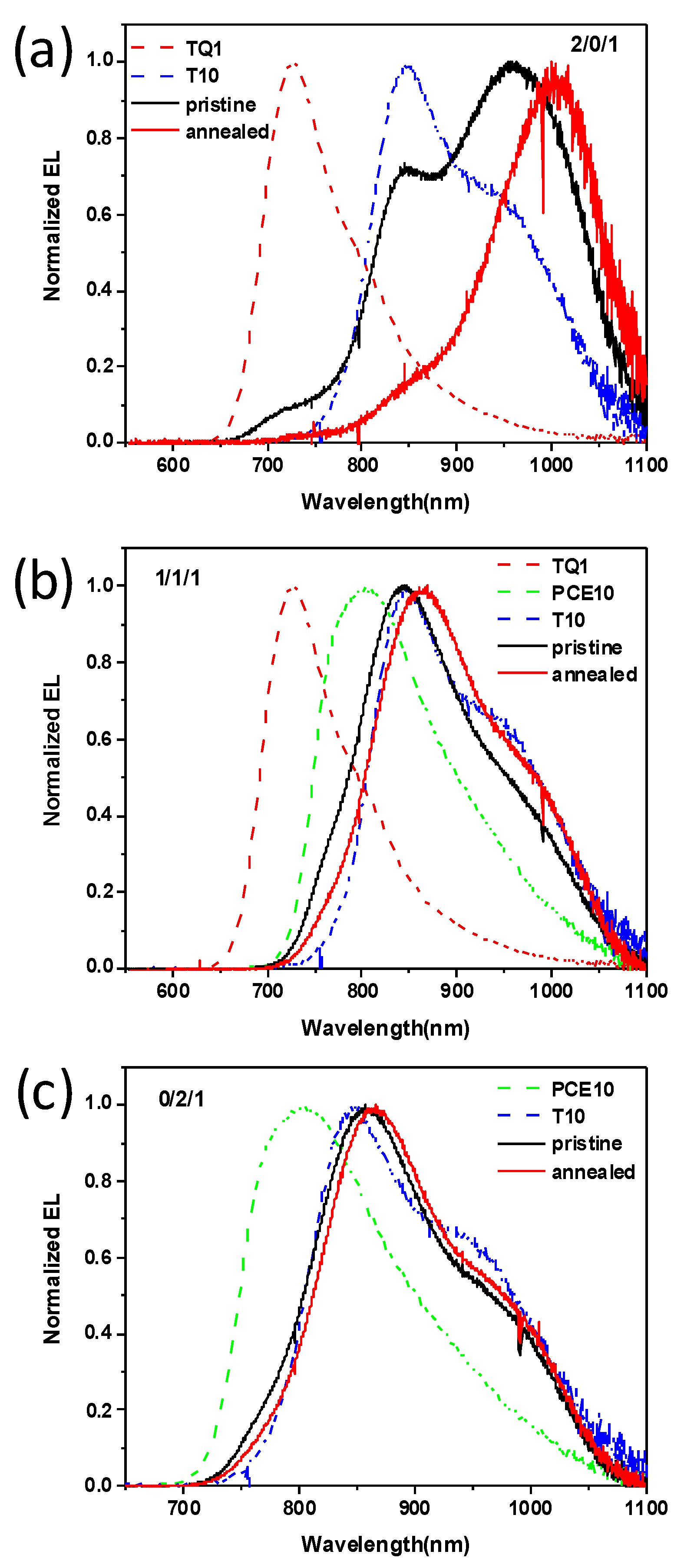
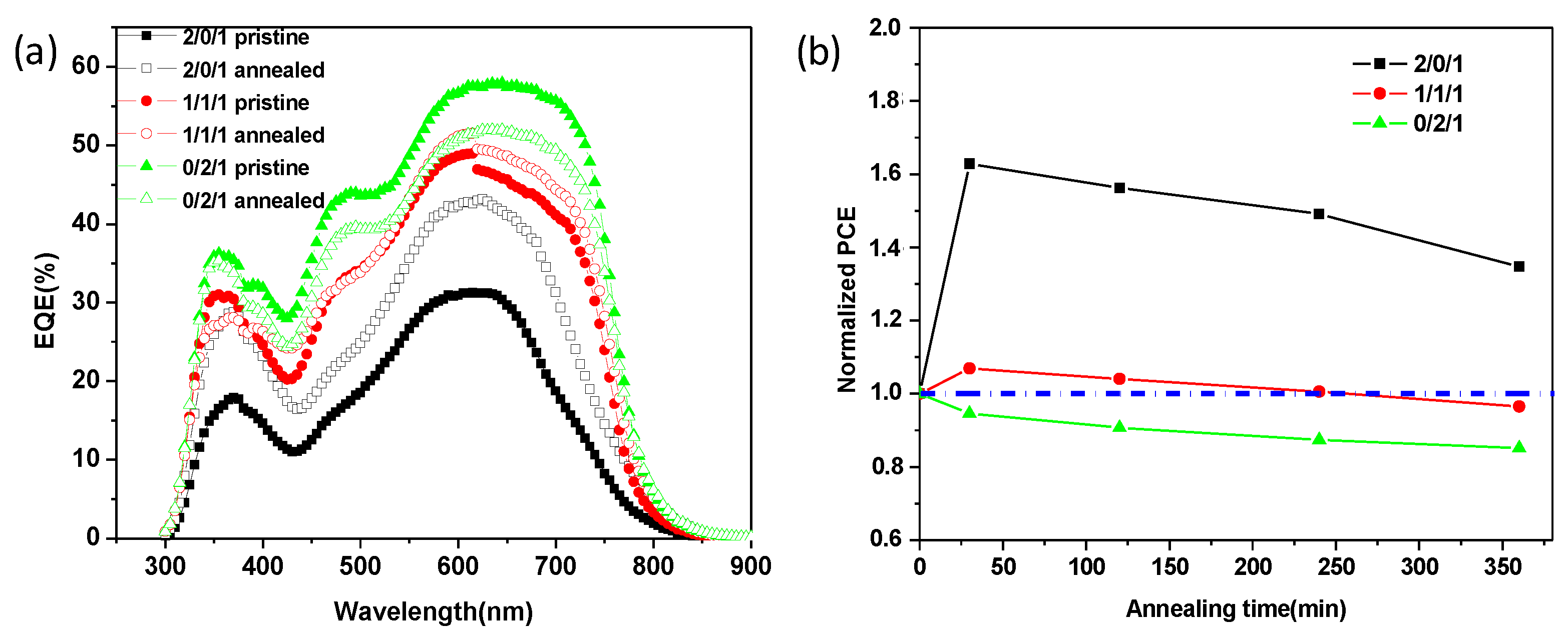
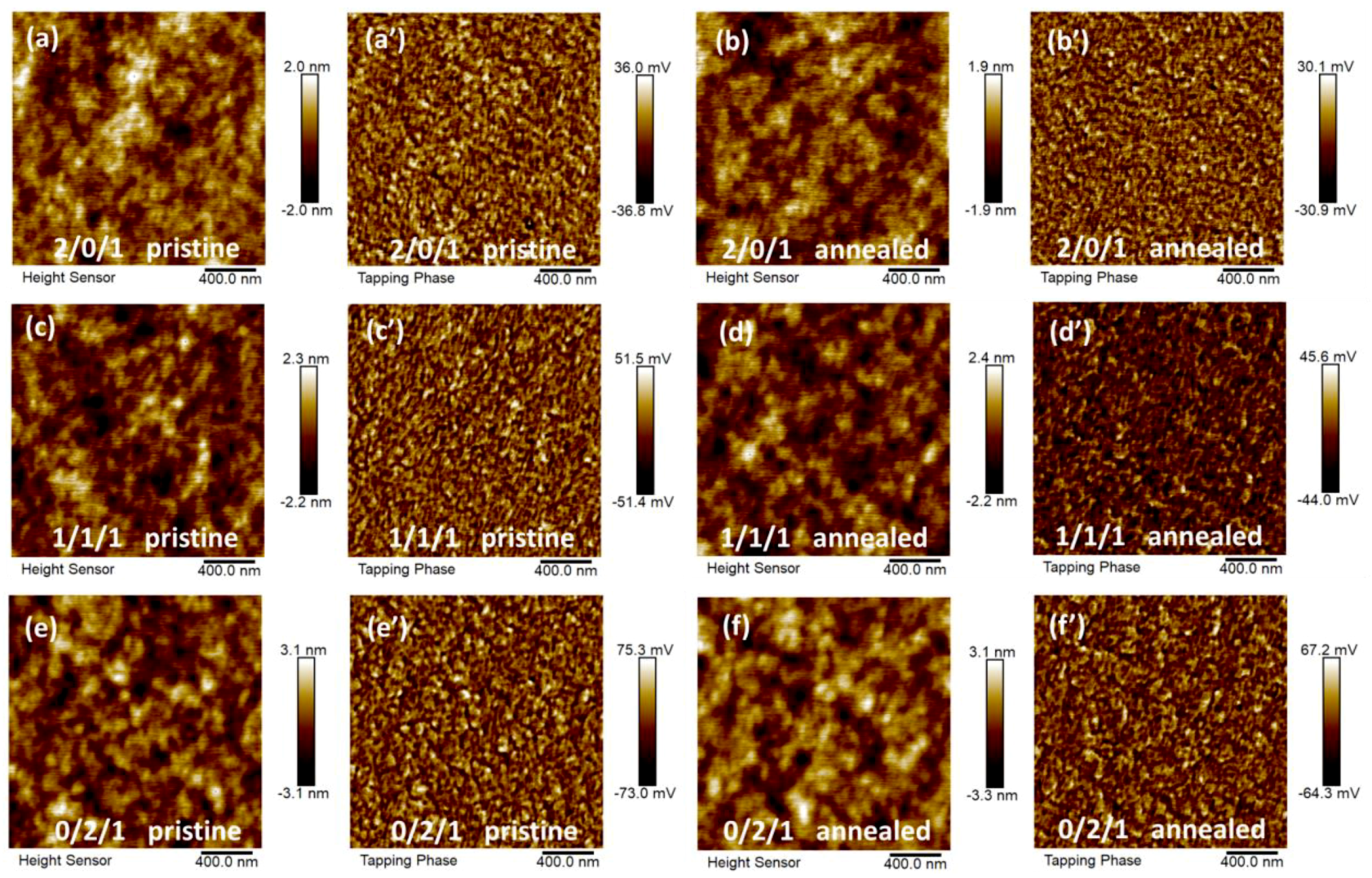
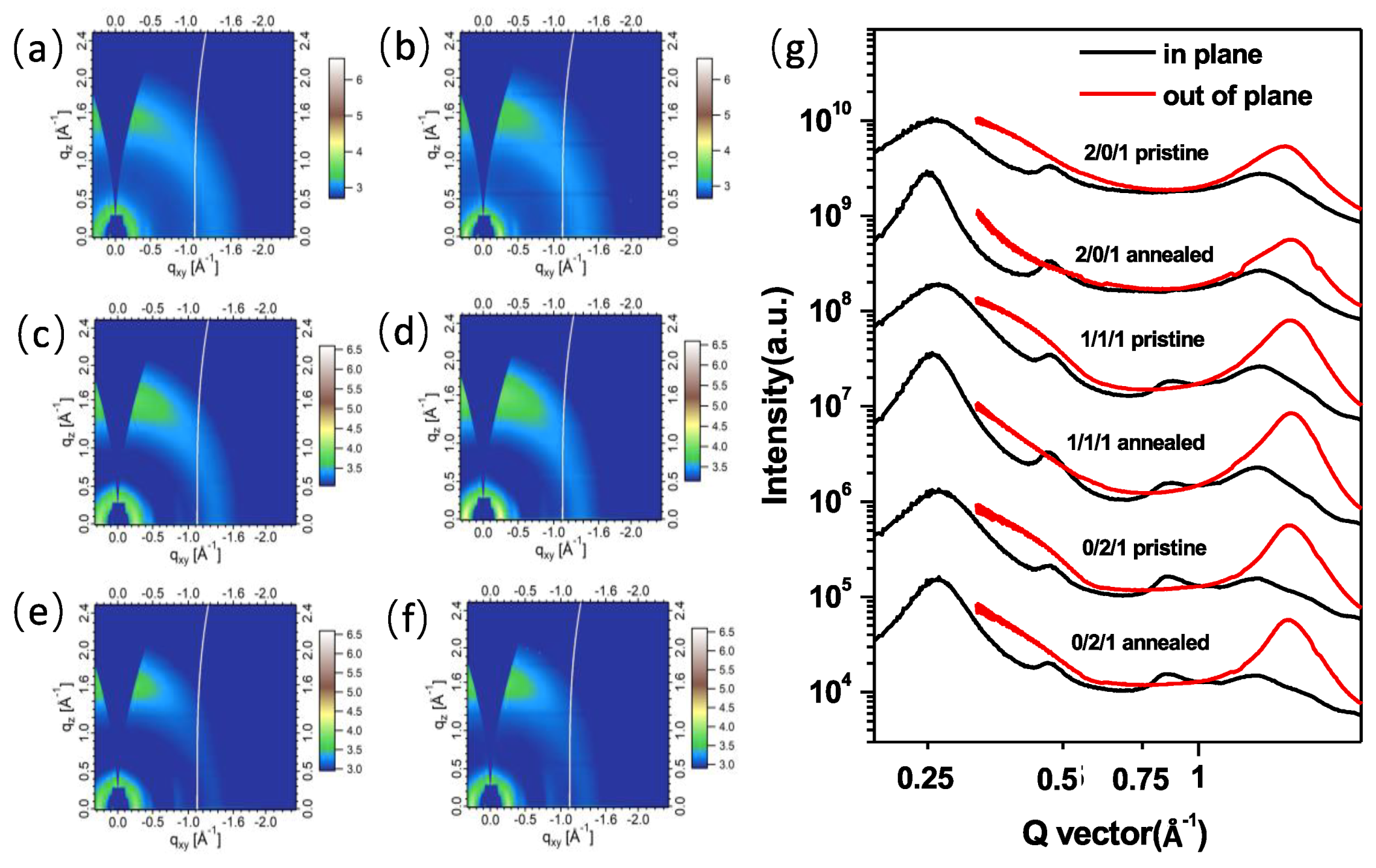
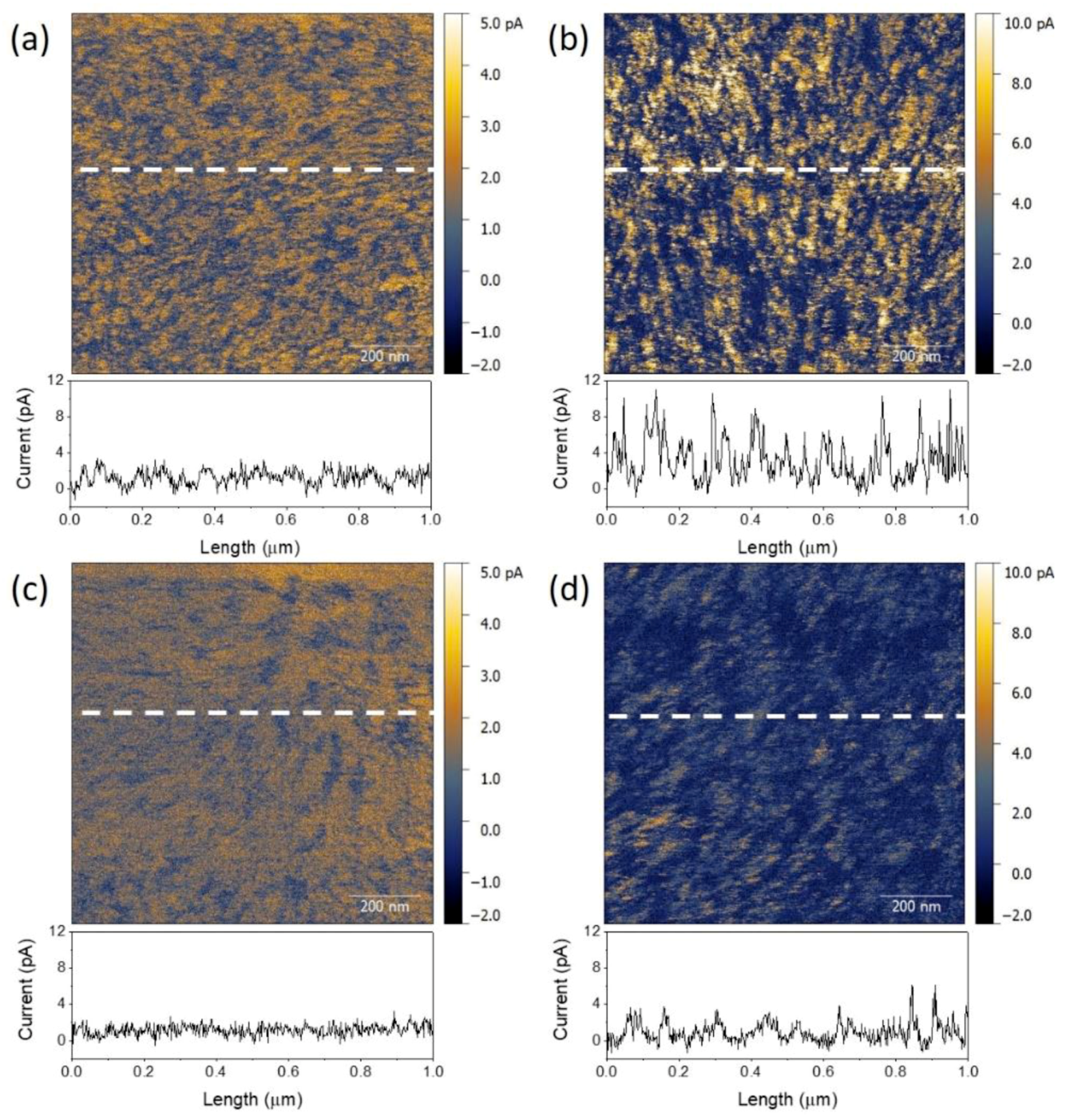
| Voc(V) | Jsc (mA/cm2) | FF | PCE/Average (%) | ||
|---|---|---|---|---|---|
| 2/0/1 | pristine | 0.93 | 5.13 | 0.45 | 2.12/2.10 |
| annealed | 0.84 | 7.39 | 0.49 | 3.05/3.00 | |
| 1.5/0.5/1 | pristine | 0.88 | 7.28 | 0.41 | 2.60/2.59 |
| annealed | 0.83 | 8.86 | 0.51 | 3.72/3.68 | |
| 1/1/1 | pristine | 0.85 | 9.39 | 0.46 | 3.64/3.57 |
| annealed | 0.82 | 9.86 | 0.50 | 4.08/4.07 | |
| 0.5/1.5/1 | pristine | 0.82 | 10.97 | 0.44 | 3.97/3.90 |
| annealed | 0.81 | 10.38 | 0.46 | 3.88/3.86 | |
| 0/2/1 | pristine | 0.81 | 12.05 | 0.43 | 4.18/4.13 |
| annealed | 0.81 | 10.82 | 0.45 | 3.96/3.93 | |
| θ ° | r (mN/m) | δ (M Pa1/2) | |
|---|---|---|---|
| TQ1 | 98.0 | 23.5 | 17.8 |
| PCE10 | 96.6 | 24.2 | 18.0 |
| PNDI-T10 | 107.6 | 18.0 | 15.6 |
© 2019 by the authors. Licensee MDPI, Basel, Switzerland. This article is an open access article distributed under the terms and conditions of the Creative Commons Attribution (CC BY) license (http://creativecommons.org/licenses/by/4.0/).
Share and Cite
Zhou, K.; Zhou, X.; Xu, X.; Musumeci, C.; Wang, C.; Xu, W.; Meng, X.; Ma, W.; Inganäs, O. π–π Stacking Distance and Phase Separation Controlled Efficiency in Stable All-Polymer Solar Cells. Polymers 2019, 11, 1665. https://doi.org/10.3390/polym11101665
Zhou K, Zhou X, Xu X, Musumeci C, Wang C, Xu W, Meng X, Ma W, Inganäs O. π–π Stacking Distance and Phase Separation Controlled Efficiency in Stable All-Polymer Solar Cells. Polymers. 2019; 11(10):1665. https://doi.org/10.3390/polym11101665
Chicago/Turabian StyleZhou, Ke, Xiaobo Zhou, Xiaofeng Xu, Chiara Musumeci, Chuanfei Wang, Weidong Xu, Xiangyi Meng, Wei Ma, and Olle Inganäs. 2019. "π–π Stacking Distance and Phase Separation Controlled Efficiency in Stable All-Polymer Solar Cells" Polymers 11, no. 10: 1665. https://doi.org/10.3390/polym11101665
APA StyleZhou, K., Zhou, X., Xu, X., Musumeci, C., Wang, C., Xu, W., Meng, X., Ma, W., & Inganäs, O. (2019). π–π Stacking Distance and Phase Separation Controlled Efficiency in Stable All-Polymer Solar Cells. Polymers, 11(10), 1665. https://doi.org/10.3390/polym11101665




